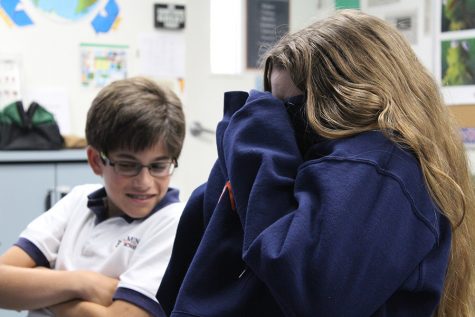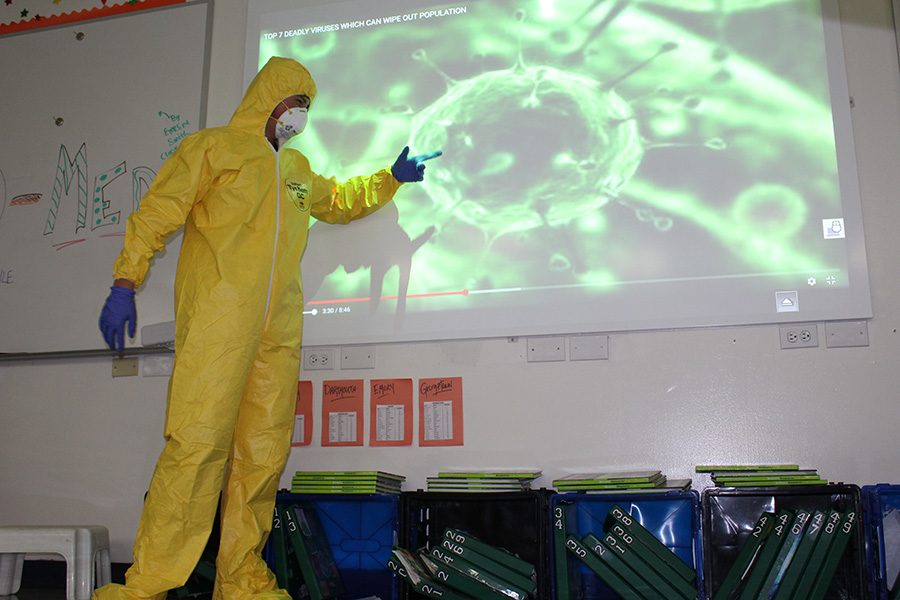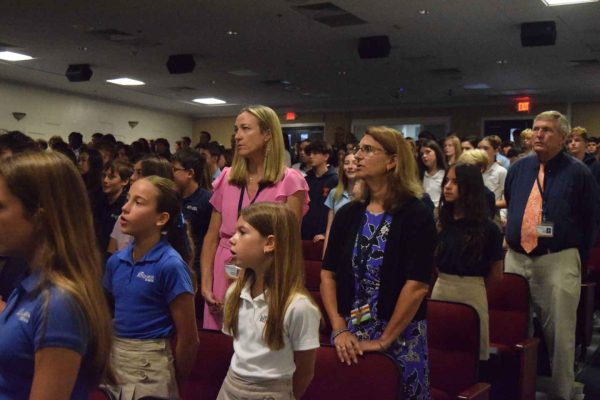Getting Gruesome with Science
The seventh-grade science classes recently delved into various diseases as part of their cell, bacteria, and virus unit.
Seventh grader Jack Horgen dons a hazmat suit in order to make his presentation on SARS.
Limbs becoming so deformed they have to be chopped off; fingers and toes becoming gnarled; swelling all over the body; bacteria forcing tissue to turn black. This is not your average trip to the nurse’s office. Instead, this is Mrs. Stephanie Oster’s seventh-grade science project, also known as “TED Med.” The name is a take on the TED Talk format. TED, according to its website (www.ted.com), stands for “technology, education, and design,” and is “a non-profit organization which believes passionately in the power of ideas to change attitudes, lives and, ultimately, the world.” TED holds conferences all over the world, and its website provides the public with inspiring TED Talks from individuals whose topics range from how to fight climate change to the practical uses of 3D holograms.

Seventh graders Jane Boyland (right) and Jake Zur look away during some graphic images of Madeline Comorat’s gangrene presentation.
For the project, every seventh grader chose either a bacteria, virus, or fungus that causes illness, and he or she made a slide presentation about these infections which cause disease. They ranged from SARS to mumps to gangrene. Seventh-grade participated in doing these projects because they have just finished their cell, bacteria, and virus unit. Researching the various ailments gets students out of their comfort zone by learning about (and seeing) many different effects diseases can have on the body.
“I want students to understand all the things we hear on the news; most the things we hear in the doctor’s office, and I want them to have ownership and understanding about what is going on,” said Oster.“This project has been going on in middle school for ten years. I adopted it from a high school level lab that my husband does with his AP biology class.” It does makes sense that if people understand the causes and effects of diseases, they will be more careful to prevent and treat them in a timely fashion.
Many students either researched diseases they have a connection to or with which they are at least a bit familiar . “I just had strep throat, so I thought it would be interesting to try to find out more about it,” said seventh grader Matthew Roundtree, who presented on the streptococcus virus. Similar to Roundtree, fellow seventh grader Ali Brown chose her infection because she has come into contact with it. “I know about dental cavities, and I don’t want to get one. Now that I know more about them, I don’t want to get even one more.”
Others chose their diseases for different reasons. “I chose meningitis because I didn’t want a disease that was too gross,” said seventh grader Jake Zur. “Meningitis is internal so it is not as gross as [some of the other] other diseases.” Madeline Comorat wanted to do the opposite of what most people wanted, “I picked [gangrene] because it was the grossest disease.” She wanted everyone to be “grossed out,” and she got what she wished for. “Everyone was making these very disgusted faces and were totally grossed out. [Classmate] Jane [Boyland] even had to put her face into her sweatshirt, it was great.”





